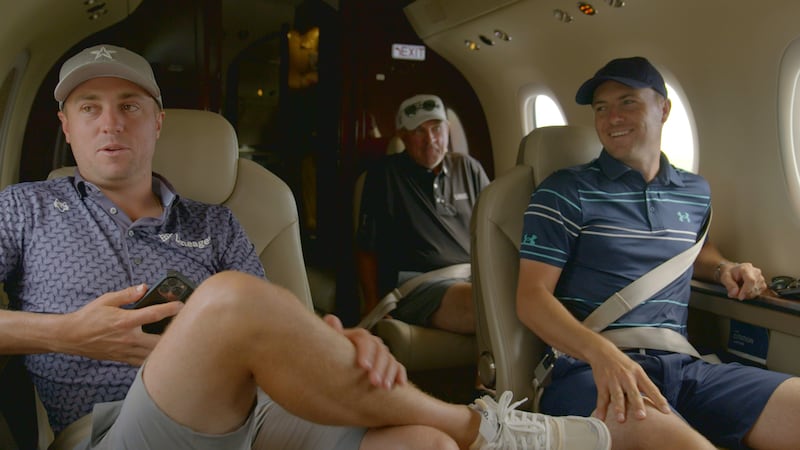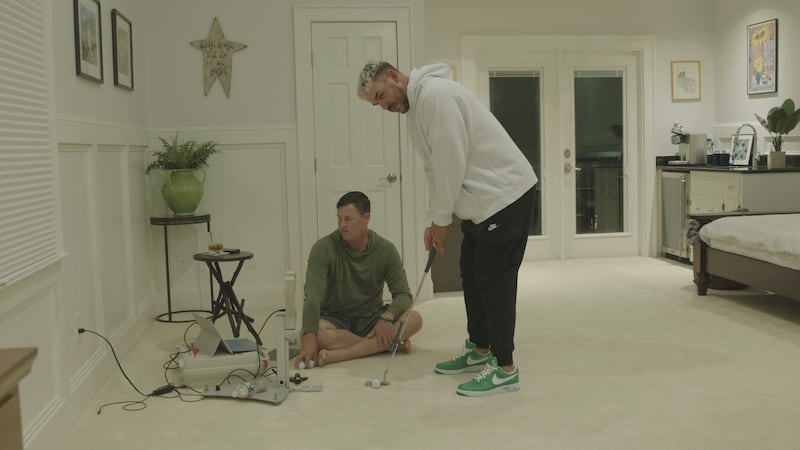At the various tournaments and championships played on the main (men’s) professional tours last year, the not-so-hidden cameras of those filming for Full Swing – which airs globally on Netflix on Wednesday next, February 15th – were apparent, capturing the on-course and off-course actions and antics and musings of players who had signed up for the season-long immersive documentary series.
There are thrown clubs in locker rooms (hat-tip to Ian Poulter) and quite a large amount of effing and blinding, akin to the sort of terrace swearing you’d find on Hill 16 (no doubt accounting for its over-15s viewing rating), which, if truth be told, provides some evidence that these players, many travelling tournament-to-tournament in private jets and with privileged lifestyles, are like most people after all.
Given the year that was in it, with the arrival of LIV Golf in 2022 fracturing the structure of the men’s professional scene, those behind the documentary – headed by chief producer Chad Mumm – came along with their cameras and microphones to immerse themselves into tour life with a sense of perfect timing. As Poulter puts it in one soundbite: “You have picked a hell of a year to start filming the PGA Tour.”
The eight-part first series is good viewing and will find an easy target audience within the golfing community. The cast of characters range from the expected – Justin Thomas and Jordan Spieth, Dustin Johnson and Brooks Koepka, and Collin Morikawa and (especially) Rory McIlroy – to the more unexpected: Joel Dahmen and Tony Finau.
Yet, the inclusions of Dahmen and Finau, effectively hogging their own, full episodes, works tremendously well in showcasing their backstories – Dahmen was diagnosed with testicular cancer in his early 20s; Finau’s mother died in a car crash when he was starting out – and demonstrating that the roads taken to success are not always the smoothest nor always from the position of privilege.

Each episode has its own storyline – a couple of dominant characters at times, for instance in the opening one featuring Spieth and Thomas, to more singular ones, as in Dahmen’s episode – and yet, as in the golfing year itself, the shadow of LIV’s impact on the PGA Tour plays out in its own way and was a factor in why McIlroy (not originally due to feature as a central character) did ultimately join the line-up and, just as he did on the golf course last year, take centre-stage in the production.
Indeed, McIlroy – speaking at the Phoenix Open earlier this week – explained why he had decided to join in.
“I sort of took the attitude of see how the first season works out, see if I like it, like the idea, feel comfortable letting cameras get into my life a little bit more. But I had a good chat with Chad in the summertime. Obviously with everything that’s going on in the world of golf, he just said having my voice in there in some way could just add a layer of context that wasn’t there already.”
The reality of the matter is that the documentary makers needed McIlroy to give credence, especially in the year that was in it when McIlroy was the player more than anyone who stepped up to the plate as a key advocate of the PGA Tour in the face of LIV. As he puts it himself, it is almost as if he were the defender of the “history” and the “legacy” and the “integrity” of golf.
Yet, McIlroy didn’t give as much as others in allowing the cameras into his private life. Unlike Koepka, for one. The cameras move into Koepka’s waterside residence in Jupiter, Florida, to provide a behind-the-keyhole view of his home life; yet, rather than the sheer luxury of his lifestyle, it’s Kopeka’s total honesty in seeking to figure out why his game has fallen away that is brilliantly captured. His soon-to-be wife, the actress Jena Sims, is filmed at one point showing the golfer various fashion purchases while the look on his face is that of someone a million miles away, and in a world of his own, figuring out what is wrong with his swing.

On the occasions when cameras intrude into Koepka’s world, we get to see his lavish residence complete with pool and sunken sunbeds and berthed boat. Another world to most of us.
We don’t get any such viewings into that away-from-golf life of McIlroy, though. One of McIlroy’s agreements for taking part in the documentary series was that his private life stayed private.
“I made sure that the parameters were very much like, ‘look, you can film me at [tournaments], you’re not coming to my house, you’re not coming in my car, you’re not coming anywhere near my family, but you want to do some stuff with me at golf tournaments, totally fine. They were the ground rules that were sort of set, and here we are.”
The series, as it should be, is player-driven. There are some breakaways into family life. The relationship, for instance, between Justin Thomas and his father Mike – a PGA professional, with golf very clearly in the family’s DNA – is shown to be of a typical father and son rather than a golfer and his coach.
Tony Finau’s episode, too, is interesting on a number of points, including the player’s early life in Salt Lake City when his parents were keen to pass on their Samoan heritage, and how his father saw golf, an alien sport to him, as a pathway to a better life for the family. Family life is important to Finau, to the extent that his wife and five children would more often than not be on tour with him.
And Finau throws out some pearls of wisdom. One of them? “A winner is just a loser who never gave up.”
One theme throughout this initial series is of how the majors – the Masters, the US PGA, the US Open and the British Open – play out as the focal points of the season. And one notable detail is how breakthrough US Open champion Matt Fitzpatrick’s self-confessed obsession with numbers and analytics (he has boxes of yardage books going back to his early teenage years) is at odds with the almost horizontal, laid-back persona of Dahmen.
Of course the series would have been better if Tiger Woods had thrown his hat into the ring. But that was never going to happen. As a first offering in what hopefully will be a long-running series of documentaries, it ticks virtually all of the boxes.
Full Swing is on Netflix from Wednesday February 15th














